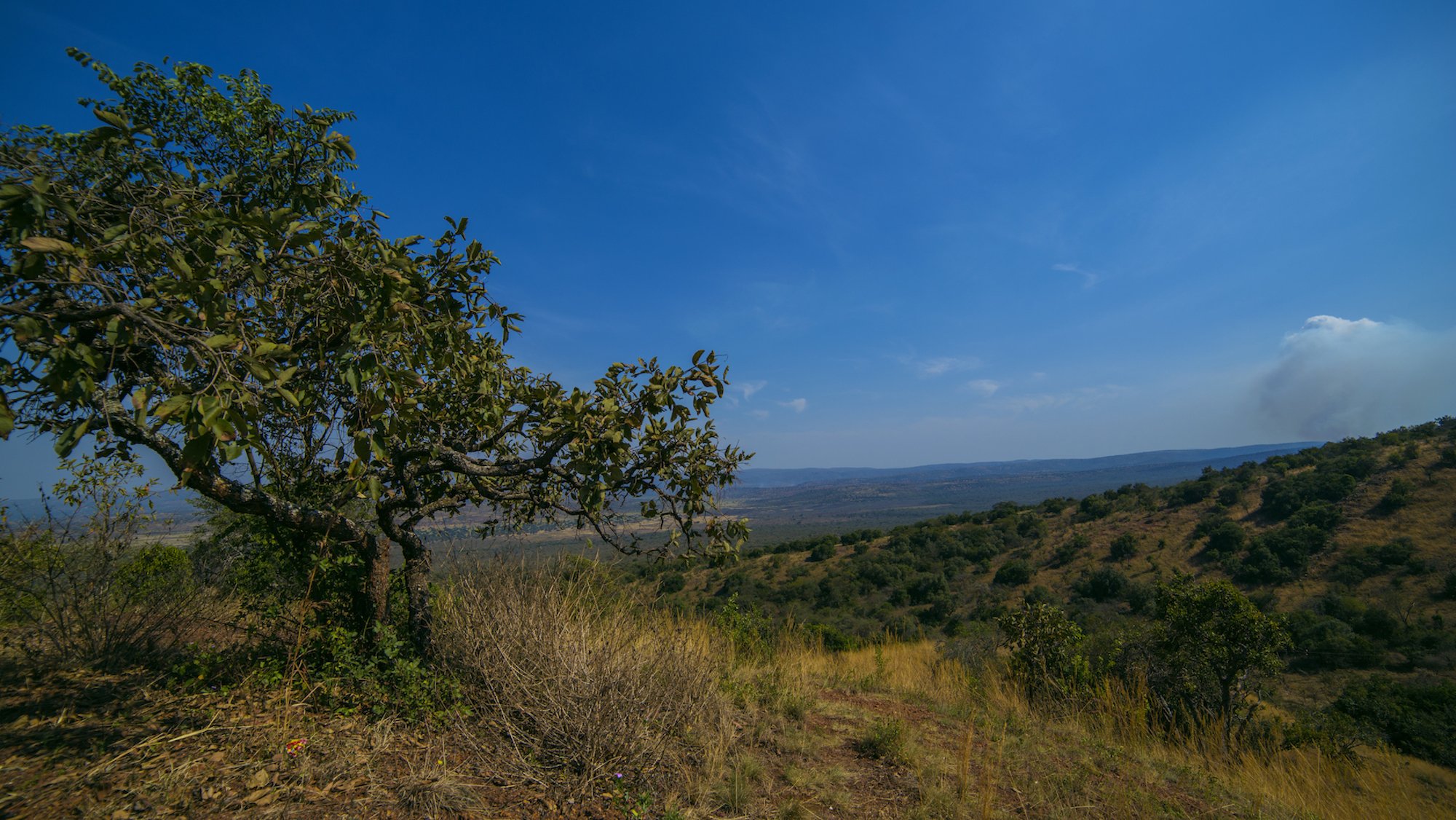This is not a picture of a lone antelope.
I mean, it is a picture of a lone antelope - it is an antelope and it is standing by itself, the definition is fully fulfilled. The reason that it’s not picture of a lone antelope, is because there is no animal named a “lone antelope.” The number of lone antelopes that exist is a null set, a void, a nothingness. And that is a bitterly disappointing fact, because I was very excited to see one.
Our safari had been going well, up until this point. Our driver was a friendly, chatty individual, and we’d had the foresight of placing Greg up front with him. Greg’s defining personality character is that he can talk to anyone, and will, whether they feel inclined to or not. I first discovered this when, during a 30-minute layover in Instanbul, he’d turned several fellow passengers waiting with us at the terminal into fast friends, despite the fact that few of them were traveling to the same place we were, and none of them spoke any English.
As we left the hotel not long after sunrise in an oversized forest-green Jeep, Greg and the driver fell quickly into a lively conversation about the city, its government, and the nature of the Rwandan people. This allowed the rest of us to immediately fall back asleep.
I awoke in the way you do when you fall asleep in a strange car - startling upright, sticky with sweat and disoriented - at the edge of Akagera National Park. The park is a long, winding chunk of country in Rwanda’s northwest border that houses much of Rwanda’s wildlife. It costs only $30 for a safari, but the park is almost entirely deserted, as most of the visitors who make up Rwanda’s sparse tourist industry choose to travel to the far north for an overnight experience living among the gorillas. In fact, we’re receiving a tour from a company that specializes in gorilla visits, with large gorilla decals plastered on the side our vehicle.
Based on stories from our guides, the gorilla experience is apparently quite something, though I am not sad that I missed it. Visitors hike deep into the forest, until they suddenly discover they are surrounded by gorillas on all sides. This is not, scientifically speaking, considered the safest position to be in. Careful steps need to be taken to ensure the tourists’ safety. If a juvenile gorilla comes up, grabs you, and pulls you away from the group (an event that is apparently a real possibility), you are supposed to obediently go with him, and the guide will “take care of it.”
I can’t think of any piece of advice I’m less likely to keep in mind in the moment when I’m being grabbed by an aggressive gorilla than “peacefully allow the animal to abduct you.” The possibility that I’d be dragged off into the underbrush with a breezy smile and an offhand “I’ll see you all at lunch, I’m sure,” was already astronomically low before I even found out what it means when a guide “takes care of it."
“The guide makes himself look big, and tries to scare the gorilla,” says our guide, who is new to the company and has apparently been trained to handle this sort of thing, but has yet to find any opportunity to apply his training.
“He tries to scare the gorilla? It’s a gorilla.”
“Apparently that’s what they do.”
“Does that even work?”
“…I don’t know.”
Keep in mind, this was a man who, if we had decided to visit the gorillas on that day, would have been my only hope in the event of a gorilla abduction.
So, should you travel to Rwanda and attempt this trip, please size up and select your guides based on their ability to look big and terrify gorillas. I personally do not plan on venturing into the jungle without anyone less qualified at this than, say, Lou Ferrigno.
Fortunately, I don’t have any such worries today, as our only animal guests are skittish creatures like impalas and warthogs (or, “McDonalds” and “Antennas” as they are known to guides here – the former by the impala’s distinctive “M”-shaped marking over their tails, and the latter by the way the animals race away from visitors, only their stiff, upright tails visible over the tall grass. Whether this is from long familiarity or a lack of ethology is never made entirely clear).
We do see hippos, which I am surprised to learn are some of the most vicious creatures on earth, a fact I feel someone should have warned me about much earlier. Hippos are some of nature’s most brutal hunters, a neat informational nugget they might have skated over in the Madagascar movies. They tend to be aggressively territorial, so they’ll drag animals (or, sometimes, people! What fun!) they catch down to the bottom of the river, hold them until they are almost out of breath, then release them so that they can swim to the surface and gasp for air for a moment or two. Then, they grab them and pull them down again. Eventually, they casually chomp their prey in two with a snap of their outrageously powerful jaws. And they aren’t even carnivores! They’re just killing animals to teach them a lesson. It lends a grisly vibe to the years I spent playing “Hungry Hungry Hippos” with my friends.
But then we get to the lone antelope. Or, what our guide tells us is the lone antelope.
“You are very lucky,” he says, pulling the car gently to a stop and sitting motionless in the front seat. “This animal is very rare. It exists only in Rwanda, and it almost never appears so near a road.”
He sounds excited, breathless even, and I immediately catch his fervor. A lone antelope! What a find! I snap as many pictures as I can before the beast moves off nervously into the woods. That night, all of my emails back home talk about the rare and exotic lone antelope I saw that day.
Except, as I mentioned, there’s no such thing as a lone antelope. A quick Wikipedia search a few days later came up empty, revealing only an oddly named property management company in California and no rare animals of any kind.
Our guide had been such a fount of information, with facts and figures rattling off the top of his head, that I hadn’t thought to doubt a word of it. But now, upsettingly, everything seemed in flux - especially the piece of information on the trip I’d found most interesting of all.
In the center of the city was a traffic circle, with a towering statue of a woman holding a small child’s hand in the center. When I asked what the statue represented, our guide had a surprisingly detailed answer ready.
In the wake of the genocide, the new Rwandan government decided that massive changes needed to be made to ensure a lasting peace. Some of the changes were small: the fourth Saturday of every month is now dedicated to community service – every Rwandan citizen drops whatever they are doing and work to improve the town by helping people build houses, improve the roads, and similar projects. Others seemed impossibly massive: discussing your tribe in public is no longer considered socially acceptable, though what sort of punishment would be leveled at offenders is somewhat unclear. And, most interestingly, they drastically increased the role of women in government.
“Women,” the driver tells us, “love peace more than men.” Men go off to war, and in their wake, women raise the children, mind the businesses, run the country, and eventually, mourn their lost sons and husbands. So in the wake of the genocide (and the subsequent flight of survivors to surrounding countries), women and girls made up about 70% of the remaining population. The Rwandan people, in a sudden and welcome break with all of human history, decided that these women deserved more of a voice, an added an electoral stipulation that 30% of Parliament must be women.
So they held an election, and once all the polls were in, it turned out that women won 46% of elected spots. Four years later, after the next election, they controlled 54% of the seats available (keep in mind, our driver is listing these statistics off the top of his head). They now led the world in female democratic representation, became the first country in the world to have a Parliament with a majority of women holding spots, and have erected a statue in the very center of their capital to honor the contributions of women in the rebuilding of their country.
If I had asked you before you read these paragraphs what the first country to have a majority of women in their Parliament, how many guesses would you have taken before you got to Rwanda? Would it have even been in your first hundred? In fact, would you have guessed any African countries at all? I’m not sure I would have.
The reason for women’s success, our driver continues, is that they are corrupted much less often than men – less likely to be seduced, less able to be bought. What’s more, they value their country’s peace more than their men do. Our driver is certain that they would be at war with Congo right now if it wasn’t for the women in power.
It sounds nice and modern, a society jumping straight from brutal genocide to progressive feminism. But after my confusion with the lone antelope, I was wary. I retreated to the internet again.
And, thrillingly, this one turned out to be true, and all of the figures listed by the driver were completely correct. Even more excitingly, it’s more true now than it was then: women have seized more seats with each passing election and now control an impressive 64% of the seats in Parliament, and remains the only country ever to exceed that 50% figure. By point of comparison, its neighbor to the west, the Democratic Republic of Congo, sits 122nd in the world in female representation, with 10.6% (the U.S., by the way, is 85th in the world, at 18.3%).
What surprised me more was the way the driver spoke of his country’s groundbreaking feminism. A man who drives people to see gorillas every day is not the sort of person you’d expect to be bragging about the way his country is at the forefront of women’s issues, but the pride in his voice was unmistakable. It made me forgive him for the way he fooled me about that lone antelope.
Especially once I pored over a website listing antelope species a few days after I got back (I told you, I was upset!), and discovered that the animal we saw was in fact the roan antelope, a beast indigenous to most of the savannah that covers central Africa.
So while I wasn't lied to, perhaps the sight of it wasn’t as impressive or rare as I was led to believe.
But I can’t be mad at the man. After all, he kept Greg occupied the whole trip home, so I could get back to sleep.





